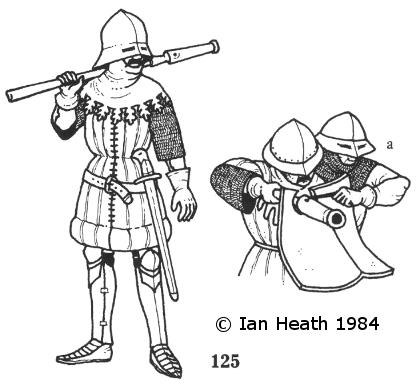Register a SNAP EBT card with Amazon

Shop Amazon - Create an Amazon Baby Registry
HUSSITE HANDGUNNER
An extract from Armies of the Middle Ages, Volume 2
by Ian Heath

[c.f. Germans attacking a Hussite Wagon Fortress, Johannes Hartlieb: 'Kriegsbuch', 1437. Österreichischen Nationalbibliothek Cod. 3062 Han]
125. HUSSITE HANDGUNNER
The earliest surviving written reference to the use of handguns in Bohemia dates to 1383, when one blew up in the hands of an 'archer', fatally wounding him.
At that time the handgun was called a puska, a term which could then equally refer to a cannon.
It was after the failure of Emperor Sigismund's first crusade against them in 1420 that the Hussites adopted the handgun,
largely as a result of a number of towns and their artisans rallying to Zizka's cause so that he was able to equip many of his men with handguns during the respite of 1422-27.
It has been estimated that in 1429 as many as 3,000 handguns were employed in Prokop the Bald's combined armies,
and certainly Oman claimed that the Hussites were the first to use the handgun on such a grand scale.
He wrote that by the end of the Hussite wars 'it is said that nearly a third of the army' were using handguns,
and that when the armies were subsequently disbanded Bohemian soldiers serving as mercenaries. . . usually . . . were handgun men',
most notable of them being those who served in Hungarian armies against the Turks.
Regardless of all this, however, one should not lose sight of the fact that it was the crossbow that was the main Hussite missile weapon,
outnumbering the handguns in their armies by up to 3 to 1.
The figure depicted here comes from a picture of a Hussite wagon-fortress in a German ms. of 1437-50 in the British Museum.
His handgun is of a short-barrelled type apparently developed by the Hussites and called a pitala (meaning 'pipe' or 'whistle').
Silesian and Lusatian sources of 1427 refer to pischolu, pischulen and pyschelin, but the word pistala only first occurs in ungarbled form in the 1430s,
after which the use of this type of gun spread to Germany and then Italy, where its name became pistole.
It also spread to the Balkans and the Ukraine, Konstantin Mihailovic referring to such guns as pissczuly in his 'Memoirs'.
A surviving example in the Museum of the Hussite Revolutionary Movement in Tabor is of iron with an overall length (including its socket) of 16¾ inches,
an inside barrel length of nearly 10 inches, and a bore of just under ¾ of an inch.
Another picture in the same source, depicting a battle between Hussites and German crusaders,
is of particular interest in that it shows a handgunner resting his pistala in the bouché of a shield as shown in 125a,
while a companion reaches across from his left to apply a match to the touch-hole. This is one of the few pictures, and the latest so far as I am aware,
to actually show the second man (called an incendiarius or 'firer',
to distinguish him from the collineator or 'aimer') sometimes referred to in the written sources as assisting a handgunner in action.
Next: 126. HUSSITE CAVALRYMAN in Armies of the Middle Ages, Volume 2 by Ian Heath


